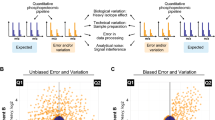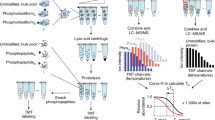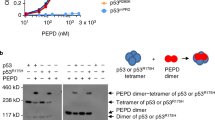Abstract
The p53 tumor suppressor regulates transcription of target genes. We have previously analysed the p53-dependent proteome and identified novel protein targets. Here we have examined p53-dependent phosphorylation using two-dimensional gel electrophoresis and staining with the fluorescent phosphoprotein dye Pro-Q Diamond. We report that p53 induces phosphorylation of a subset of proteins including Nm23, DJ-1, ANXA1 and PrxII. Our identification of p53-dependent phosphorylation of specific target proteins reveals new aspects of the p53-dependent cellular response and suggests that such posttranslational modifications may contribute to p53-mediated tumor suppression.
This is a preview of subscription content, access via your institution
Access options
Subscribe to this journal
Receive 50 print issues and online access
$259.00 per year
only $5.18 per issue
Buy this article
- Purchase on Springer Link
- Instant access to full article PDF
Prices may be subject to local taxes which are calculated during checkout



Similar content being viewed by others
References
Arur S, Uche UE, Rezaul K, Fong M, Scranton V, Cowan AE et al. (2003). Annexin I is an endogenous ligand that mediates apoptotic cell engulfment. Dev Cell 4: 587–598.
Bonifati V, Rizzu P, van Baren MJ, Schaap O, Breedveld GJ, Krieger E et al. (2003). Mutations in the DJ-1 gene associated with autosomal recessive early-onset parkinsonism. Science 299: 256–259.
Bretaud S, Allen C, Ingham PW, Bandmann O . (2007). p53-dependent neuronal cell death in a DJ-1-deficient zebrafish model of Parkinson's disease. J Neurochem 100: 1626–1635.
Chen SL, Wu YS, Shieh HY, Yen CC, Shen JJ, Lin KH . (2003). P53 is a regulator of the metastasis suppressor gene Nm23-H1. Mol Carcinog 36: 204–214.
Kim RH, Peters M, Jang Y, Shi W, Pintilie M, Fletcher GC et al. (2005). DJ-1, a novel regulator of the tumor suppressor PTEN. Cancer Cell 7: 263–273.
Lavin MF, Gueven N . (2006). The complexity of p53 stabilization and activation. Cell Death Differ 13: 941–950.
Liu J, Minemoto Y, Lin A . (2004). c-Jun N-terminal protein kinase 1 (JNK1), but not JNK2, is essential for tumor necrosis factor alpha-induced c-Jun kinase activation and apoptosis. Mol Cell Biol 24: 10844–10856.
MacDonald NJ, De la Rosa A, Benedict MA, Freije JM, Krutsch H, Steeg PS . (1993). A serine phosphorylation of Nm23, and not its nucleoside diphosphate kinase activity, correlates with suppression of tumor metastatic potential. J Biol Chem 268: 25780–25789.
Mihara M, Erster S, Zaika A, Petrenko O, Chittenden T, Pancoska P et al. (2003). p53 has a direct apoptogenic role at the mitochondria. Mol Cell 11: 577–590.
Nagakubo D, Taira T, Kitaura H, Ikeda M, Tamai K, Iguchi-Ariga SM et al. (1997). DJ-1, a novel oncogene which transforms mouse NIH3T3 cells in cooperation with ras. Biochem Biophys Res Commun 231: 509–513.
Rahman R, Latonen L, Wiman KG . (2005). hTERT antagonizes p53-induced apoptosis independently of telomerase activity. Oncogene 24: 1320–1327.
Rahman-Roblick R, Johannes Roblick U, Hellman U, Conrotto P, Liu T, Becker S et al. (2007). p53 targets identified by protein expression profiling. Proc Natl Acad Sci USA 104: 5401–5406.
Ryan KM, Phillips AC, Vousden KH . (2001). Regulation and function of the p53 tumor suppressor protein. Curr Opin Cell Biol 13: 332–337.
Solito E, Christian HC, Festa M, Mulla A, Tierney T, Flower RJ et al. (2006). Post-translational modification plays an essential role in the translocation of annexin A1 from the cytoplasm to the cell surface. FASEB J 20: 1498–1500.
Solito E, de Coupade C, Canaider S, Goulding NJ, Perretti M . (2001). Transfection of annexin 1 in monocytic cells produces a high degree of spontaneous and stimulated apoptosis associated with caspase-3 activation. Br J Pharmacol 133: 217–228.
Taira T, Saito Y, Niki T, Iguchi-Ariga SM, Takahashi K, Ariga H . (2004). DJ-1 has a role in antioxidative stress to prevent cell death. EMBO Rep 5: 213–218.
Vousden KH, Lu X . (2002). Live or let die: the cell's response to p53. Nat Rev Cancer 2: 594–604.
Wang L, Patel U, Ghosh L, Chen HC, Banerjee S . (1993). Mutation in the nm23 gene is associated with metastasis in colorectal cancer. Cancer Res 53: 717–720.
Acknowledgements
We thank Dr Bengt Fadeel (Karolinska Institutet, Stockholm, Sweden) for the rabbit polyclonal anti-Annexin 1 antibody and for helpful comments. This work was supported by the Swedish Cancer Society, the Cancer Society of Stockholm, the Swedish Medical Research Council (VR) and Karolinska Institutet.
Author information
Authors and Affiliations
Corresponding author
Additional information
Supplementary Information accompanies the paper on the Oncogene website (http://www.nature.com/onc).
Supplementary information
Rights and permissions
About this article
Cite this article
Rahman-Roblick, R., Hellman, U., Becker, S. et al. Proteomic identification of p53-dependent protein phosphorylation. Oncogene 27, 4854–4859 (2008). https://doi.org/10.1038/onc.2008.124
Received:
Revised:
Accepted:
Published:
Issue Date:
DOI: https://doi.org/10.1038/onc.2008.124
Keywords
This article is cited by
-
Annexin A1 expression in a pooled breast cancer series: association with tumor subtypes and prognosis
BMC Medicine (2015)
-
Consequences of DJ-1 upregulation following p53 loss and cell transformation
Oncogene (2012)
-
Lemur tyrosine kinase-2 signalling regulates kinesin-1 light chain-2 phosphorylation and binding of Smad2 cargo
Oncogene (2012)
-
Current advances in the application of proteomics in apoptosis research
Science China Life Sciences (2011)
-
In GFP with high risk HPV-18E6 fusion protein expressed 293T and MCF-7 cells, the endogenous wild-type p53 could be transiently phosphorylated at multiple sites
Journal of Experimental & Clinical Cancer Research (2008)



